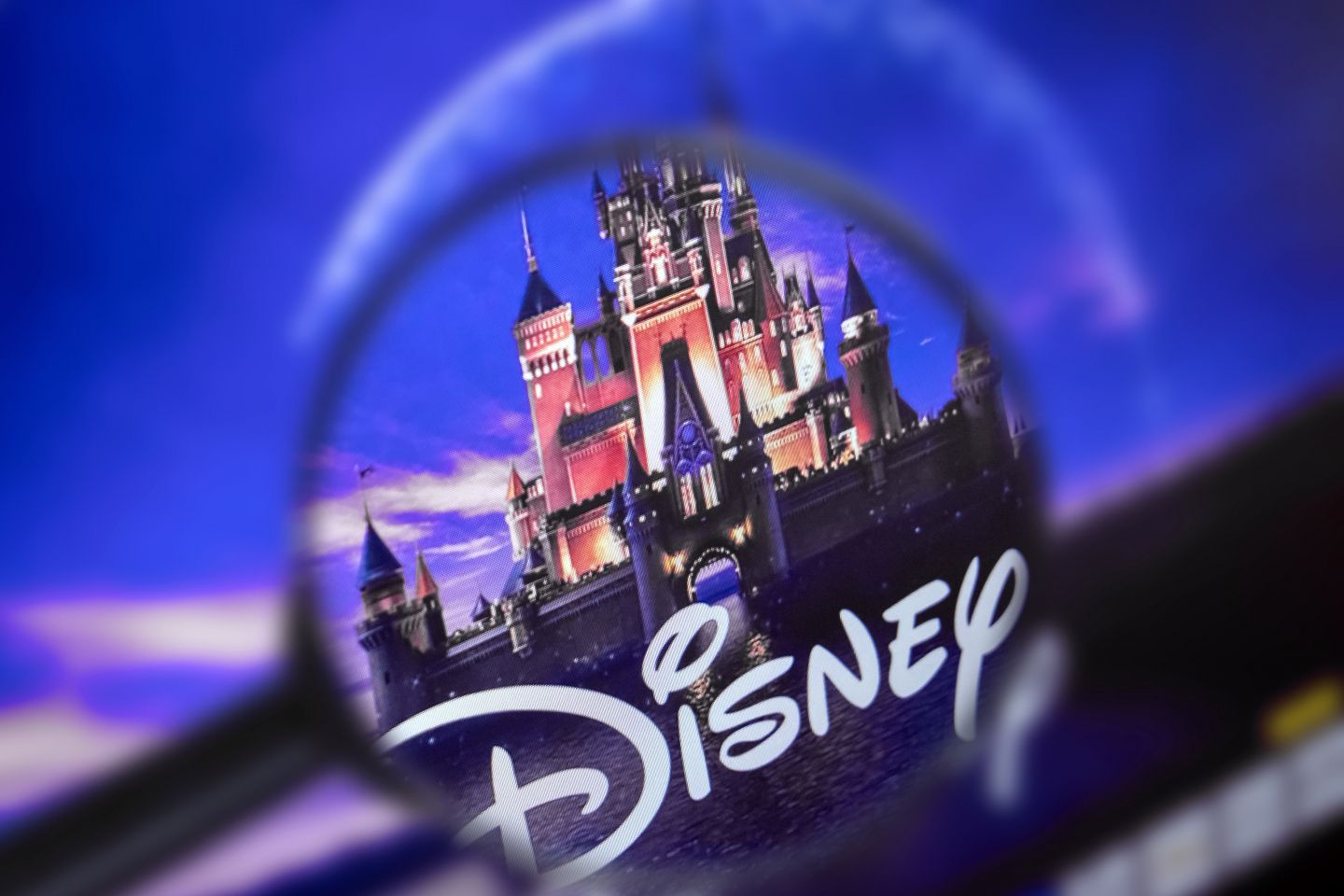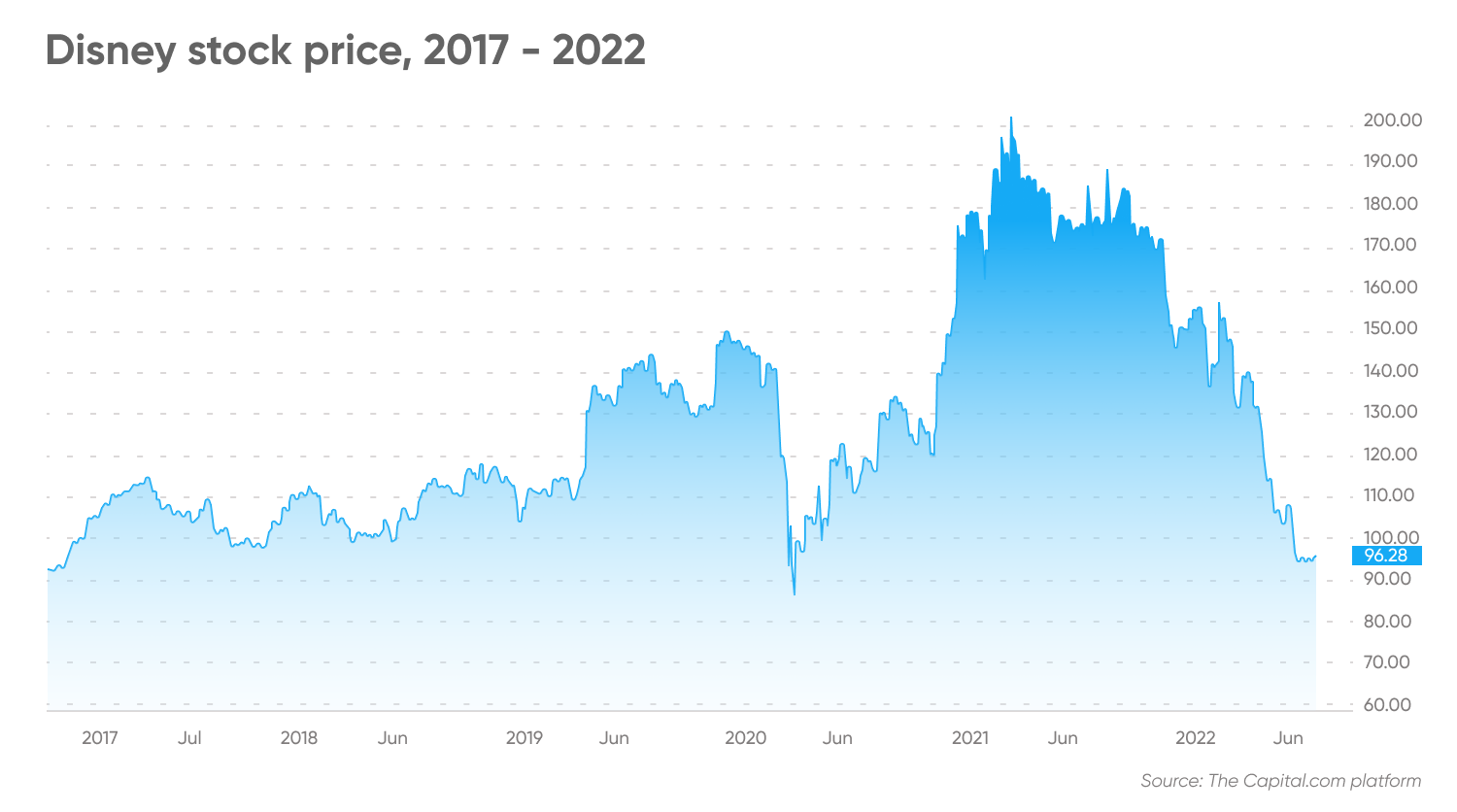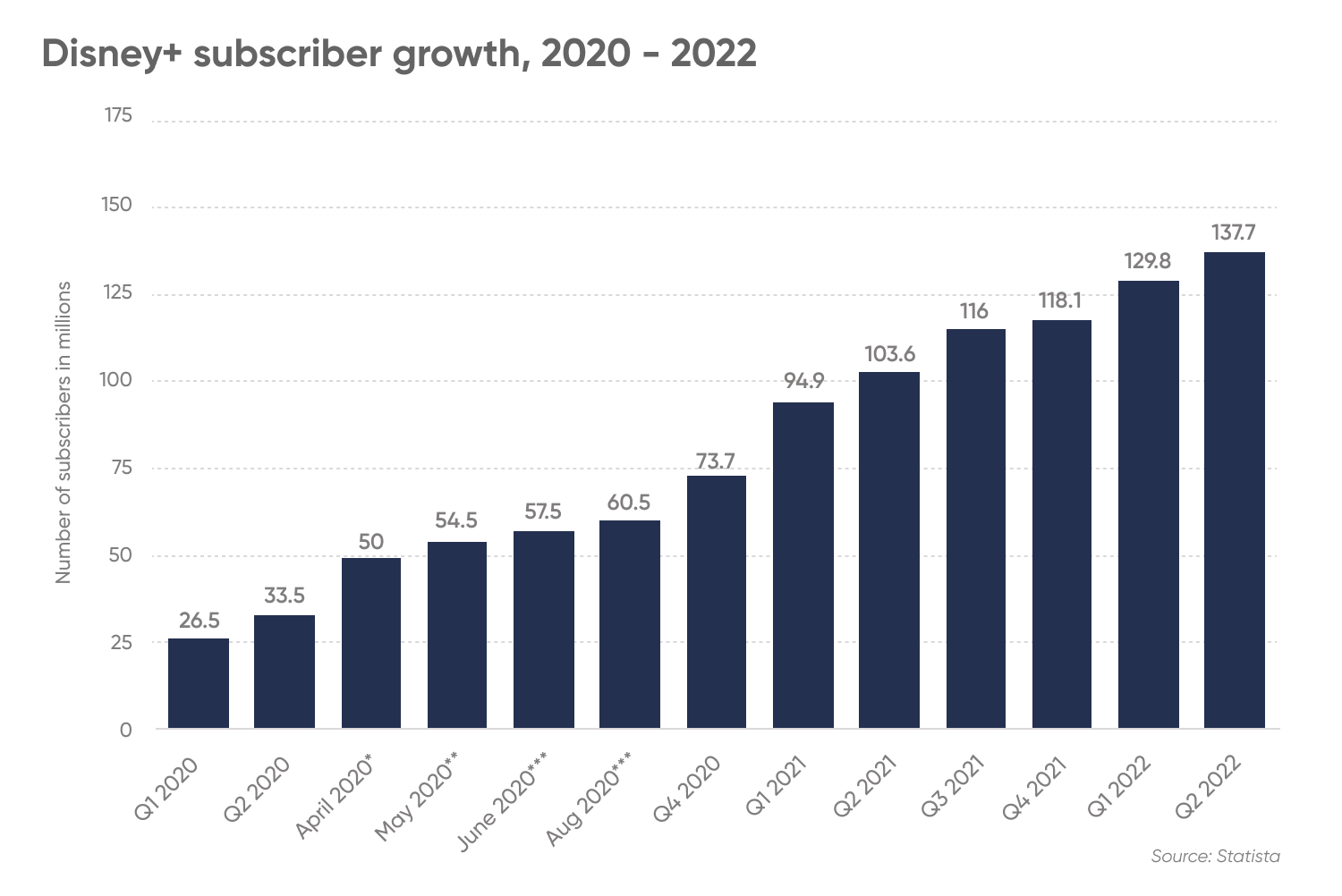Disney stock forecast: Will the stock find its magic again?
Slowing streaming demand and inflation may not bode well for the entertainment giant
Disney (DIS) is seeing the magic fade from its stock after gaining during the Covid-19 pandemic-induced boom experienced by streaming services.
Since reaching an all-time high closing price in March 2021, Disney stock has been spiralling down to below its pre-pandemic level. At the time of writing (1 December 2022), the stock last closed at $97.87 per share on 30 November, having sunk 51.8% from its all-time high price of $203 on 8 March 2021.
The entertainment company, which will celebrate its centennial anniversary in 2023, is facing headwinds such as fourth-quarter earnings that fell short of analysts' expectations and a looming recession, which may lead to consumers cutting down on non-essential spending such as entertainment costs.
Fiercer competition from streaming rival Netflix (NFLX) and a post-pandemic slowing of the stay-at-home trend have put pressure on its streaming services. On the other hand, the company’s theme park and film-making businesses have resumed with the lifting of Covid-19 restrictions.
In early November, Disney made a surprise leadership change, reinstalling Bob Iger as CEO, in an attempt to turn things around. Furthermore, Disney paid $900m for Major League Baseball’s remaining 15% stake in the streaming company BAMTech (MLB), according to a SEC filing on 30 November.
Can Disney fight its way out of the slump? We take a look at recent news, the stock’s price history and the latest Disney stock forecast.
What is Disney?
The Walt Disney Company is a diversified international family entertainment and media enterprise. The California-based company’s businesses include media networks, studio entertainment, interactive media, consumer products, theme parks and resorts.
The history of the company started when brothers Walt and Roy founded the Disney Brothers Cartoon Studio on 16 October 1923, following Walt’s success in selling his first pilot cartoon film series, Alice Comedies. The name was changed to The Walt Disney Studio at Roy’s suggestion.
Throughout its near century-long history, Disney has grown into a multi-billion-dollar business, famous for its flagship family-oriented brands. Disney has also acquired several companies to reach wider audiences. The list includes 21st Century Fox, Marvel Studios, Lucasfilm, Pixar and Blue Sky Studios.
Marvel Studios and Lucasfilm have continuously produced some of the world’s highest-grossing movies through franchises such as the Marvel Cinematic Universe and Star Wars series.
As of July 2022, the company operates two main business segments: Disney Media and Entertainment Distribution (DMED), and Disney Parks, Experiences and Products (DPEP).
DMED covers global film and episodic television content production and distribution activities. The content is distributed by a single organisation across three significant lines of business: Linear Networks, Direct-to-Consumer and Content Sales/Licensing. Studios, General Entertainment and Sports create the content.
DPEP’s operations has two main business lines: Parks & Experiences and Consumer Products. Park & Experiences operates all Disney’s resorts, hotels, Disneyland parks, a four-ship vacation Disneyland Cruise Line, and other entertainment facilities.
Consumer Products’ operations consist of licensing and retail. The former provides licences on a diverse range of product categories, including toys, apparel, games, accessories, and footwear. It also licenses characters from its film, television and other properties for use on third-party products and earns royalties.
Some of the major properties licensed by the company include: Mickey and Minnie Mouse, Star Wars, Frozen, Disney Princess, Avengers, Spider-Man, Toy Story, Disney Classics, Winnie the Pooh and Cars. On the retail operation, the company sells Disney, Marvel, Pixar and Lucasfilm-branded products through retail stores and internet sites globally.
Disney stock analysis and historical performance
Disney stock is listed on the New York Stock Exchange (NYSE) under the ticker DIS. It is also a constituent of the S&P 500 index (US500).
Historical Disney stock price data showed that from July 2017 to March 2019, the stock value fluctuated between $98 and $116 a share. The price, however, started to spike after 20 March 2019, following Disney’s acquisition of 21st Century Fox.
The acquisition included Fox’s renowned film production business Twentieth Century Fox, as well as Fox’s interests in streaming service Hulu, which helped the company to compete with rival streaming titan Netflix.
Disney’s stock price gained 31.9% during 2019, compared to around a 2% increase in 2018.

While the Covid-19 pandemic hit Disney with theme park closures and cancelled shows, the strong performance of its streaming services supported the company’s performance. Revenues from Disney’s streaming services, including Disney+ and Hulu, under Direct-to-Consumer & International, jumped 41% in the fourth quarter of 2020 to $4.9bn and 81% to nearly $17bn for the fiscal year 2020 ending 3 October.
In 2020, Disney pleased its shareholders with around 25% stock return. The company rode the pandemic-induced streaming boom into the first quarter of 2021.
The stock hit an all-time high closing price of $201 on 8 March 2021, after California announced it would allow ballparks, stadia and theme parks to reopen for outdoor activities starting 1 April 2021.
However, as the pandemic progressed to a more manageable stage, with Covid-19 restrictions being gradually lifted in line with rising vaccine roll-out, the streaming boom started to fade and Disney’s stock subsequently has given up its gains.
Since the beginning of 2022, Disney’s stock has declined by 37%, steeper than 14.51% lost over 2021 and was 1.5% below the pre-pandemic price of $99.40 on 16 October 2017, according to Trading View data.
What happened to Disney stock? Key price drivers
Disney has been on a downward trajectory since the beginning of 2022, despite starting strong at $157.83 on 3 January. At the time of writing (1 December 2022), the stock was trading at $97.64, below the pre-pandemic level.
The reopening of economies and activities around the world has slowed demand for streaming services, as employees and children have either fully or partially returned to offices and schools.
In addition, rising US inflation started to bite into household spending around the time when streaming services, including Netflix, raised their subscription fees. The US Consumer Price Index (CPI) was running at an annual rate of 7.7% in October, easing from the peak of 9.1% in June. However, it was still way above the inflation target of 2%.
Netflix (NFLX) also reported slowing revenue growth in the third quarter of 2022, ending September with year-on-year revenue growth of 5.9% compared to 16.3% in the same period of 2021. The company forecast YoY revenue growth in the fourth quarter of 2022 to decelerate to 0.9%.
Q4 revenue below estimates
The Walt Disney company reported revenue growth of 9% and 23% for the fourth quarter and the full fiscal year 2021/2022 ended 1 October 2022 respectively, the company announced on 8 November.
Fourth-quarter revenue rose to $20.15bn from $18.53bn a year ago, but was 4.5% lower than consensus estimates polled by Zacks.com. Revenue in the 2021/2022 fiscal year increased to $82.72bn, from $67.41bn in the same period in the previous fiscal year.
A closer look at its segments reveals that revenue from Disney Media and Entertainment Distribution fell 3% year-over-year (YoY) to $12.72bn in the fourth quarter of 2022 owing to widening losses for Direct-to-Consumer (DTC) and Content Sales/Licensing.
Direct-to-Consumer’s (DTC) operating loss jumped to $1.47bn in the fourth quarter of fiscal 2021/2022, from $630m in the previous fiscal year. DTC’s full year 2021/2022 revenue was up 8% to $55.04bn, from $50.86bn during the same period a year earlier.
Disney’s chief financial officer Christine McCarthy said during the earning call on 8 November that she believed the losses in Direct-to-Consumer had peaked.
DTC’s operating results were expected to improve by at least $200m in the first quarter of fiscal 2023 versus the fourth quarter of 2022, partly supported by increases in subscription prices, she added.
Stronger revenue from Disney’s Parks & Experiences segment helped to cushion losses from the DTC. In the fourth quarter of 2022, Parks & Experiences booked revenue of $7.42bn, jumping 36% from the year-ago period of $5.45bn.
It booked earnings per share (EPS) of $0.30 in the fourth quarter, down from $0.37 in the prior-year quarter.
Subdued Q1 2022/2023 outlook
In the earnings call on 8 November, CEO Bob Chapek said the company still expected to achieve profitability in fiscal 2024, with losses expected to decrease in the first quarter of fiscal 2023 and no significant shifts in the economic environment. 
The company added 14.6 million new subscriptions from its streaming service in the fourth quarter, bringing its total subscriptions for 2021/2022 to more than 235 million, said Chapek. The number includes 12 million Disney+ subscribers and nine million Core Disney+ subscribers.
However, Disney’s CFO Christine McCarthy said Disney+ Core subscribers were expected to only increase slightly in Q1 2022/2023 before accelerating in the next quarter. Subscribers of Disney+ Hotstar were projected to decline in the first quarter 2022/2023 after it lost rights to air the Indian Premier League (IPL) cricket games.
For 2023 fiscal year, Disney expected to spend cash content in the low of $30bn and $6.7bn of capital expenditure, up from $5bn in the 2022 fiscal year, McCarthy said.
Susannah Streeter, Hargreaves Lansdown’s senior investment and markets analyst, said that while Disney’s subscribers growth has been impressive, the revenue growth rate was expected to start slowing.
Disney stock predictions: Can Iger bring back Disney’s magic?
On 10 November, Disney reinstalled Robert A. Iger as chief executive officer as Chapek stepped down. In the surprise boardroom shuffle, Iger will serve as Disney’s CEO for two years.
Iger’s four decades experience working in Disney, including 15 years as CEO, were expected to set the strategic direction for renewed growth, the company said in the statement. During Iger’s leadership from 2005 to 2020, Disney expanded its business with acquisitions of blockbuster-producing film studios Pixar, Marvel, Lucasfilm and 21st Century Fox.
Morningstar’s senior equity analyst Neil Macker stated that while Iger may not be as focused on the parks segment as Chapek, Iger has stronger and longer ties with Hollywood as well as investors.
On the business side, Morningstar’s maintained its view that the firm’s direct-to-consumers products, such as Disney+, Hotstar, Hulu, and ESPN+ are set to be the drivers of its long-term growth.
“Streaming will benefit from the new content being created at Disney and Fox television and film studios as well as the deep libraries at the studios. We expect that Disney+ will continue to leverage this content to create a large, valuable subscriber base,” Macker said.
ESPN remains the premier domestic sports television network due to its extensive sports programming. It earns the largest affiliate fees per subscriber of any cable channel and generates cash from advertisers looking to reach adult males aged 18 to 49, a critical demographic.
Disney Channel’s programming is made up of internally developed hits based on Disney’s extensive library of feature films and animated characters.
Macker also expected Disney’s animated franchises across multiple platforms – from movies, home videos, to musicals – to continue to grow as more popular movies get released by the animated studio and Pixar.
While Covid-19 restrictions have limited its theme park operations, Macker believed the segment will rebound after capacity restrictions are lifted, partly because families still view the parks as prime vacation destinations.
Morningstar assigned Disney a wide economic moat rating and $170 fair value estimate in its Disney stock forecast.
Disney stock forecasts and price targets
As of 1 December, 22 analysts tracked by Market Beat recommended a ‘moderate buy’ rating for Disney stock, while 19 recommended a ‘buy’ and three gave a ‘hold’ rating. The consensus 12-month average Disney share price forecast was $132.07, a 34.95% potential increase from the closing price of $97.87 on 30 November. The Disney stock price targets ranged from a low of $94 to the high of $185.
Wall Street analysts do not provide long-term Disney share price projections. However, using the stock price history, algorithm-based price prediction service Wallet Investor can generate Disney’s stock price forecast beyond 2022.
The service’s algorithm-driven forecasting system said the stock is an acceptable long-term investment. In the site’s Disney stock forecast for 2023, Wallet Investor projected the stock to trade at $108.72 in December 2023.
The site suggested the stock could reach $118.328 in three years, according to its Disney stock forecast for 2025. Meanwhile, Disney stock could rise to $121.991 in November 2027, according to the site’s projection.
When looking for Disney stock projections, remember that analysts and algorithm-based predictions can be wrong, and shouldn’t be used as a substitute for your own research.
Always conduct your own due diligence by reviewing the most recent analyst commentary, Disney stock news, technical and fundamentals analysis. Remember that your decision to trade or invest should be based on your risk tolerance, market expertise, portfolio size and investment goals.
Bear in mind that past performance does not guarantee future results, and never invest or trade money that you cannot afford
Is Disney a good stock to buy?
As of 1 December 2022, analysts tracked by MarketBeat gave Disney stock a ‘moderate buy’ rating. However, whether Disney stock is a good buy will depend on your investing goals and portfolio composition.
Analysts can be wrong and their Disney share price forecasts shouldn’t be used as a substitute for your own research. You should conduct your own due diligence, and never invest or trade money you cannot afford to lose.
How high can the Disney stock price go?
According to data compiled by MarketBeat as of 1 December 2022, the consensus average analyst price target for the coming 12-month period was $132.07. The Disney stock price targets ranged from a high of $185 and a low of $94.
Bear in mind that analyst views can be wrong, and that there are many factors that drive the company’s stock price. Remember that markets are volatile, and that past performance cannot guarantee future results.
Should I invest in Disney stock?
Your decision to invest in Disney stock should be based on your risk tolerance, investing goals, and portfolio composition. You should do your own research about the stock by reading the latest DIS stock news, technical and fundamental analysis.
Never invest or trade money that you cannot afford to lose.
How many Disney shares are there?
There are 1.82 billion Disney shares outstanding, which places the stock’s total value at $174.30bn as of 30 November 2022, according to Companiesmarketcap.